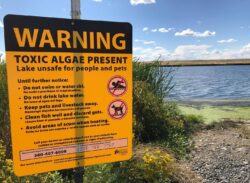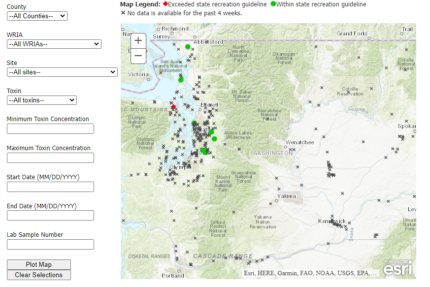I am always hearing about harmful algae blooms and how I should be aware of them and report them. But… how do I identify a harmful algae bloom?
Signed, Wondering
Dear Wondering:
Harmful algae (cyanobacteria) blooms (HABs) are already occurring in Washington lakes this year and will continue throughout the summer and fall. Unfortunately, not all lakes are monitored regularly, so it is essential that everyone know the signs and symptoms of HABs to reduce adverse exposures.
In short, there is no simple way to identify HABs on site or to tell if toxins are present. As a general rule of thumb, “WHEN IN DOUBT, STAY OUT!!!” Below are a few FAQs to help clear the “water” on this common question!
Why are HABs so bad?
The main risk of HABs is their ability to produce toxins that can poison humans, pets, or wildlife. Symptoms of exposure depend on what type of toxin is present and how much is consumed. The severity of illnesses varies, but pets are often more prone to exposure which can lead to severe or fatal effects. In addition, HABs can cause skin rashes and often produce a strong, unpleasant smell. Your nose may know!
What do HABs look like?
 HABs vary in their appearance, but there are common signs to watch for. For example, blooms often look like spilled blue or green paint (hence the common name, “blue-green” algae) in swirls, or they may have a slight foaming scum that gathers on the water’s surface. If lake managers identify toxic algae in a lake, yellow warning signs or red danger signs may be posted at public access points. There’s a great “gallery” of blooms and scums to help identify HABs at: https://www.nwtoxicalgae.org/Gallery.aspx.
HABs vary in their appearance, but there are common signs to watch for. For example, blooms often look like spilled blue or green paint (hence the common name, “blue-green” algae) in swirls, or they may have a slight foaming scum that gathers on the water’s surface. If lake managers identify toxic algae in a lake, yellow warning signs or red danger signs may be posted at public access points. There’s a great “gallery” of blooms and scums to help identify HABs at: https://www.nwtoxicalgae.org/Gallery.aspx.
How do I know if toxins are in the water?
Not all HABs are toxic, and scientists do not know what triggers toxin production. However, the larger the bloom, the more likely it is that high concentrations of toxins are present. HABs can evolve rapidly, and a bloom that is non-toxic one day may produce toxins the next day. You can’t tell by looking whether a bloom is toxic, so always assume that toxins are present and avoid exposure. Find your lake and its most recent toxicity data at the Washington State Toxin Algae website.
Where am I most likely to find blooms?
HABs often occur in warm, shallow environments, so they are often found near lake shorelines. Stagnant embayments, marinas, or shallow beaches are common locations for blooms. However, cyanobacteria are easily pushed by winds and can travel across a lake rapidly depending on conditions.
What time of year are HABs present in Washington?
HABs can occur nearly any month of the year in Washington lakes, but are most likely during summer or early fall. Each lake is different, so keep an eye out no matter what time of year it is!
What do I do if I encounter a HAB?
The best thing to do is to contact your local health department (https://www.nwtoxicalgae.org/Contact.aspx) so that the lake can be tested for cyanobacteria and toxins as soon as possible. Lake managers rely heavily on residents and the public to report blooms, so please, please reach out if you think you see a HAB!
For more information about HABs in Washington lakes, check out the following resources:
- Washington State Toxic Algae (nwtoxicalgae.org)
- Cyanobacteria Resources | Washington State Department of Health
- Harmful Algal Blooms | US EPA
It takes everyone to manage our lakes — so thank you for your diligence!



